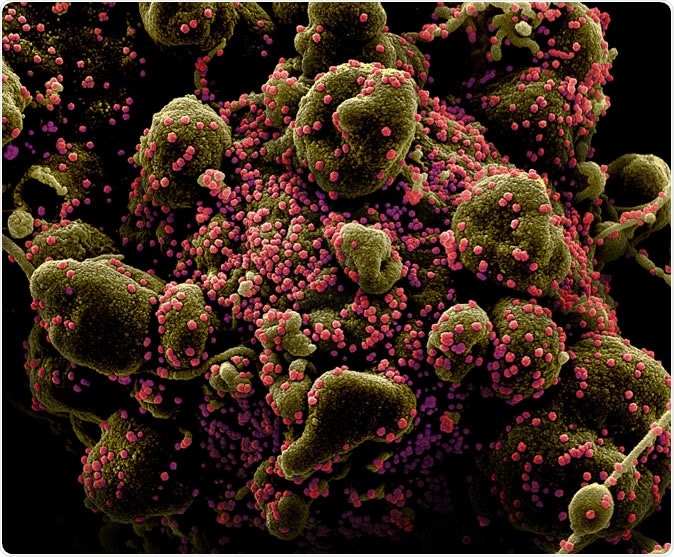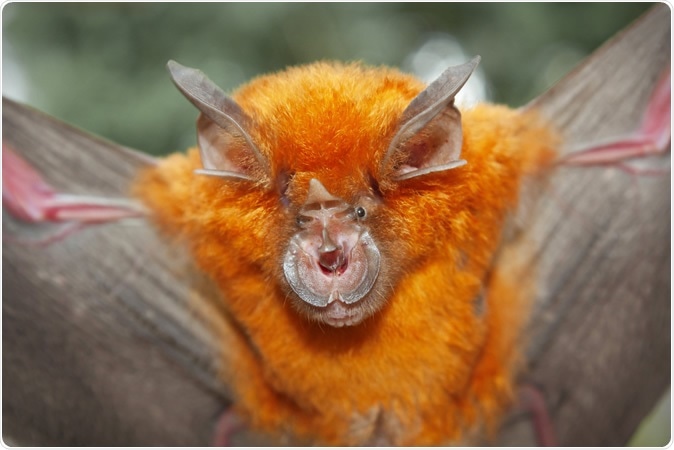A new study from Canada and the U.S. suggests that severe acute respiratory syndrome coronavirus 2 (SARS-CoV-2) may have already been pre-adapted to human transmission when it emerged in late 2019, which means there may be lingering populations of progenitor SARS-CoV-2 adept for human transmission and coronavirus disease (COVID-19) re-emergence. The research is published on the preprint server bioRxiv* in May 2020.

Novel Coronavirus SARS-CoV-2 Colorized scanning electron micrograph of an apoptotic cell (greenish brown) heavily infected with SARS-COV-2 virus particles (pink), isolated from a patient sample. Image captured and color-enhanced at the NIAID Integrated Research Facility (IRF) in Fort Detrick, Maryland. Credit: NIAID

 *Important notice: bioRxiv publishes preliminary scientific reports that are not peer-reviewed and, therefore, should not be regarded as conclusive, guide clinical practice/health-related behavior, or treated as established information.
*Important notice: bioRxiv publishes preliminary scientific reports that are not peer-reviewed and, therefore, should not be regarded as conclusive, guide clinical practice/health-related behavior, or treated as established information.
Several reports have demonstrated that SARS-CoV-2, the causative agent of the ongoing COVID-19 pandemic, is genetically stable and not under much pressure to adapt. This finding could increase the effectiveness of vaccines that are currently in development.
If we go back into the past, we can see that there were two original SARS outbreaks in the period from 2002 to 2004 – each originating from disparate palm civet-to-human transmission events of SARS-CoV. Due to assiduous animal and human host tracking and lessons from the first epidemic, the second outbreak was swiftly suppressed.
In order to prevent analogous consecutive outbreaks of COVID-19 today, it is therefore pivotal to understand lessons from the past and enact precise measures for risk minimization of additional SARS-CoV-2-like precursors adapting to and re-emerging among humans. This can be done by identifying the route by which the new coronavirus adapted for human transmission.
However, at the moment, the evidence is scarce to support any specific scenario of SARS-CoV-2 adaptation. Was the virus transmitted across species into humans and circulated undiscovered for months before the end of 2019, accumulating adaptive mutations on the way? Or was it already well adjusted for humans while in bats or another intermediate species?

Intermediate Horseshoe Bat (Rhinolophus affinis). Image Credit: Binturong-Tonoscarpe
The more important question for global health is whether the pool of human-adapted progenitor viruses still subsists in animals. And even remote probability that a viral precursor could have adapted to human host while being studied in a laboratory should be taken into account.
These are some pertinent questions that Dr. Shing Hei Zhan from the University of British Columbia in Vancouver and Fusion Genomics Corporation in Burnaby (Canada), together with Dr. Benjamin E. Deverman and Dr. Yujia Alina Chan from Broad Institute of MIT and Harvard (United States) aimed to answer in their recent bioRxiv paper.
Understanding genomic stability and evolutionary dynamics
To gain a better understanding of the stability of the SARS-CoV-2 genome, the researchers initially carried out a side-by-side comparison of evolutionary dynamics between SARS-CoV-2 and the original SARS-CoV. This was done by curating high-quality genomes across three-month periods; more specifically, there were 11 genomes for early-to-mid SARS-CoV epidemic, 32 genomes for late SARS-CoV epidemic, as well as 46 genomes for SARS-CoV-2 from early December 2019 to March 2020.
This was followed by comparing and contrasting the evolutionary dynamics of SARS-CoV and SARS-CoV-2 in terms of the non-synonymous and synonymous substitution rates in each gene, ensuring at the same time, adequate geographic spread in the sampling.
.jpg)
Novel Coronavirus SARS-CoV-2: This scanning electron microscope image shows SARS-CoV-2 (round gold objects) emerging from the surface of cells cultured in the lab. SARS-CoV-2, also known as 2019-nCoV, is the virus that causes COVID-19. The virus shown was isolated from a patient in the U.S. Credit: NIAID-RML
The main drawback of this approach is the potential inflation of genetic diversity due to sampling from diverse/high traffic locations, as well as skewed results due to factors such as viral transmission rate and effective population size. In addition, a sampling bias towards isolates with a more recent common ancestor may, in turn, underestimate genetic diversity.
A quest for the elusive intermediate host
There has been ample debate among researchers and the public on whether SARS-CoV-2 originated from the Huanan Seafood Wholesale Market in Wuhan. Although the Chinese CDC suggested that the virus originated from animals that were sold there, phylogenetic tracking indicates that SARS-CoV-2 may have been imported into the market by humans.

A traditional market in Asia where bats are sold as food alongside other animals as dogs or snakes. Image Credit: Maurizio Biso / Shutterstock
The authors of this study were surprised by observing that SARS-CoV-2 resembles SARS-CoV in the late phase of the 2003 outbreak after the virus developed several advantageous adaptations enabling human-to-human transmission. Moreover, January market isolates share almost 100% genome identity with a December human SARS-CoV-2 strain, which makes an intermediate host theory less probable.
"Our observations suggest that by the time SARS-CoV-2 was first detected in late 2019, it was already pre-adapted to human transmission to an extent similar to late epidemic SARS-CoV", highlight study authors. "However, no precursors or branches of evolution stemming from a less human-adapted SARS-CoV-2-like virus have been detected", they add.
In short, the SARS-CoV-2 genomes withing the market samples most likely stemmed from humans infected with SARS-CoV-2 who were market visitors or vendors. If intermediate animal hosts were also at the market, no evidence has been found in the genetic samples available.
Key messages and strategies
Such lack of definitive evidence verifying or ruling out the adaptation in an intermediate host species, humans or laboratories, means precautions against several scenarios have to be taken in order to prevent disease re-emergence.
"We would like to advocate for measured and effective approaches to identify any lingering population(s) of SARS-CoV-2 progenitor virus, particularly if these are similarly adept at human transmission", say study authors in their paper.
Several strategies that proved to be fundamental during the first SARS-CoV outbreak in detecting viral adaptation to humans and cross-species transmission could be re-applied in today's pandemic to wipe out progenitor pools rapidly.
These strategies are: animal sampling (from markets, farms and wild populations), evaluating human specimens banked months before the end of 2019 for SARS-CoV-2-like viruses or reactive antibodies, as well as appraising the under- or over-representation of food/animal handlers among the index cases to determine whether SARS-CoV-2 precursors may have been circulating among the animal trading community.
"Sequencing more SARS-CoV-2 isolates from Wuhan, particularly early isolates if they still exist, could identify branches originating from a less human-adapted progenitor as was seen in the 2003 SARS-CoV outbreak", explain study authors.
In any case, during these additional investigations, it would be advisable to extensively limit human activity that may lead to prolonged or increased contact with wild animals and their habitats. Preventing re-emergence should be a top priority in preserving global health.

 *Important notice: bioRxiv publishes preliminary scientific reports that are not peer-reviewed and, therefore, should not be regarded as conclusive, guide clinical practice/health-related behavior, or treated as established information.
*Important notice: bioRxiv publishes preliminary scientific reports that are not peer-reviewed and, therefore, should not be regarded as conclusive, guide clinical practice/health-related behavior, or treated as established information.
Journal reference:
- Preliminary scientific report.
Zhan, S.H., Deverman, B.E. & Chan, Y.A. (2020). SARS-CoV-2 is well adapted for humans. What does this mean for re-emergence? bioRxiv. https://doi.org/10.1101/2020.05.01.073262.